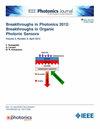基于载流子耗尽的推挽式硅光学调制器与 T 轨慢波电极的等效电路模型
IF 2.1
4区 工程技术
Q3 ENGINEERING, ELECTRICAL & ELECTRONIC
引用次数: 0
摘要
T 型轨道电极是提高硅光电调制器性能的有效方法。为了设计和优化 T 型轨电极,工程师通常依赖有限元数值模拟,这需要复杂的器件建模和巨大的计算资源。本文介绍了基于载流子耗尽的推挽式硅调制器的等效电路模型。从等效电路中可以得出调制器带宽的解析解。利用该分析解法在节省内存和灵活性方面具有优势。等效电路模型计算出的值与全波 HFSS 数值模拟结果非常吻合。因此,所提出的模型可以准确、高效地开发硅光学调制器。本文章由计算机程序翻译,如有差异,请以英文原文为准。
Equivalent Circuit Model of the Carrier-Depletion-Based Push-Pull Silicon Optical Modulators With T-Rail Slow Wave Electrodes
The t-rail electrode is an effective method to enhance the silicon optoelectronic modulator's performance. To design and optimize T-rail electrodes, engineers often rely on finite-element numerical simulations that require complex device modeling and enormous computing resources. In this paper, we present an equivalent circuit model for carrier-depletion-based push-pull silicon modulators with T-rail electrodes. The analytical solution for the bandwidth of the modulator can be derived from the equivalent circuit. The utilization of the analytical solution offers advantages in terms of memory conservation and flexibility. The values calculated by the equivalent circuit model are in excellent agreement with the numerical full-wave HFSS simulations. Hence, the proposed model can accurately and efficiently develop silicon optical modulators.
求助全文
通过发布文献求助,成功后即可免费获取论文全文。
去求助
来源期刊

IEEE Photonics Journal
ENGINEERING, ELECTRICAL & ELECTRONIC-OPTICS
CiteScore
4.50
自引率
8.30%
发文量
489
审稿时长
1.4 months
期刊介绍:
Breakthroughs in the generation of light and in its control and utilization have given rise to the field of Photonics, a rapidly expanding area of science and technology with major technological and economic impact. Photonics integrates quantum electronics and optics to accelerate progress in the generation of novel photon sources and in their utilization in emerging applications at the micro and nano scales spanning from the far-infrared/THz to the x-ray region of the electromagnetic spectrum. IEEE Photonics Journal is an online-only journal dedicated to the rapid disclosure of top-quality peer-reviewed research at the forefront of all areas of photonics. Contributions addressing issues ranging from fundamental understanding to emerging technologies and applications are within the scope of the Journal. The Journal includes topics in: Photon sources from far infrared to X-rays, Photonics materials and engineered photonic structures, Integrated optics and optoelectronic, Ultrafast, attosecond, high field and short wavelength photonics, Biophotonics, including DNA photonics, Nanophotonics, Magnetophotonics, Fundamentals of light propagation and interaction; nonlinear effects, Optical data storage, Fiber optics and optical communications devices, systems, and technologies, Micro Opto Electro Mechanical Systems (MOEMS), Microwave photonics, Optical Sensors.
 求助内容:
求助内容: 应助结果提醒方式:
应助结果提醒方式:


